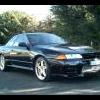Big throttle body
Announcements
-
Similar Content
-
Latest Posts
-
2001 BE5D Subaru Legacy B4 RSK (3rd gen) EJ208 (pink injector) Twin Turbo 280PS 5-speed manual Full time 4WD "RSK" grade which means all of the above LQC option which means stock rear spoiler I got it primarily to export to someone outside Japan who was interested. These BE5 Legacy B4 RSKs are going through a bit of a resurgence right know in Japan as they are one of the few cars from the "turbo, manual, RWD/4WD, 280hp gentleman's agreement era" cars that don't require stupid money to purchase. Which for some people might be a good opportunity to get as a base for restoration. If I can't find anyone to purchase it I will certainly be doing that myself over the long term. Why? Because it's properly fast in stock form, handles well enough for a GT sedan, there's still enough aftermarket and (if you can wait a while) genuine part support to make it a restoration candidate (<-- that will only get worse over time so it's a case of do it now or choose get a BL5 4th Gen). Mechanically it's fine, has only 89,200kms on the odometer. The problem with this car is that the body and exterior trims are weathered from at least the last 10 years being parked outdoors. I'm the 3rd owner, the first owner was the one that had it for 14 years and barely drove it, had a low-speed front impact (which didn't damage anything behind the radiator support) and got it fixed and sold it. The 2nd owner put most of the kms on it and parked it outside for the last 10 years, hence the door rubbers have seen better days but if you overlook those cosmetic details, it presents pretty nicely. There is some minor rust on the LH rear wheel arch which I'll have looked at too at some stage. Also as you'd expect from a car this age, the clear top coat is gone, leaving a satin finish on the roof. Mechanically it's fine (as you would expect from a car with less than 100K kms) but the steering does feel slightly vague around the centre position at higher speeds. So first on the list is to get the steering rack bushes looked at. There's also the Lock button on the remote which doesn't work, but the Open button does.... it means that the anti-theft system thinks it's always open? It seems like if you open the car and don't start the engine within 3 mins or so the anti-theft kicks in again without any beeps or signals. So if you got to start it after that, it won't. You have to push the open button again. That's how I understand it anyway. Just a small irritation but not a big problem to sort out. There's only one mod, the Wangan SPL muffler. Just a tad louder than stock. It's a really good mod for those who don't want to wake the neighbours but still want to hear a more prominent unequal length header EJ20 sound. Anyway I hope to get all those things done eventually, that is unless someone wanted to import it to their country from Japan (where I live). I'm open for negotiations as I really would like a Skyline... but this will definitely suffice in the meantime 🙂 *Disclaimer: This is how I picked it up from the dealer, minus the stuff on the back seat. I haven't cleaned the engine bay or done a thorough exterior clean, aside from spray painting the wipers.
-
Wow, even with the Audi logo centre caps. I love OEM wheel mismatches.
-
By davemoto63 · Posted
Hey all, a little help from the Stagea hive mind plz.. I'm days away from buying either a 2002 Stagea 250tRS AR-X Four, premium leather, power seats and all the old switches etc that go with it, or a 2002 Stagea 250tRS VR-X Four AERO, pov pack, cloth seats etc, with coil overs, sports zorst, comes with original zorst and suspension and parts. (I think I've got the models right?) Both are VQ25DET, have 160000kms, both straight no rust both with $2000+ in recent servicing receipts, both ride on aftermarket 18" rims. The Aero has a replaced turbo as well. I like the cool factor of the Aero car but the AR-X has never been modified. Neither have been driven hardly at all in the last 5 years. Any thoughts on which one or does it come down to personal preference? davemoto
-






Recommended Posts
Create an account or sign in to comment
You need to be a member in order to leave a comment
Create an account
Sign up for a new account in our community. It's easy!
Register a new accountSign in
Already have an account? Sign in here.
Sign In Now